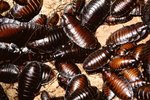
Madagascar hissing cockroaches have a gentle nature. This, combined with their large size and interesting behaviors, makes them a suitable insect species for the laboratory and classroom or as a personal pet. These large, 2- to 4-inch-long wingless roaches are endemic to Madagascar in the wild, where they live in the dry leaf litter of the rainforest.
Tubercles
Both male and female Madagascar hissing cockroaches possess dorsal tubercles -- protrusions resembling horns or bumps -- on the prothorax, although the male’s tubercles are much more conspicuous than the female’s. It’s easy to confuse these large horns with eyes, although the horns aren’t technically on the roach’s head. The head is actually under and protected by the prothorax.
Antennae
Both sexes have a pair of long antennae, like other roach species. The male and female antennae differ, though, albeit slightly. The male’s antennae are slightly thicker, fuzzier or hairier than the female’s, particularly near the base where they connect to the head. In some cases, you may need a magnifier or microscope to see the difference, although it’s typically visible to the naked eye.
Behavior
Males are the aggressive sex while females tend to be more sociable and laid back with conspecifics. In the wild and in captivity, these roaches often form large social aggregations, but the males are quite territorial. The male will choose his territory, either a hole in a log or some structure within the enclosure. Many females and young will gather on the log or structure with the male, although other males will be chased or fought off. An intruding male will trigger a hissing battle, with the larger, more dominant male typically hissing more. Males use their large horns to ram into each other during combat; they’ll also shove each other around with their abdomens. In general, the larger male wins. Horn-to-horn combat doesn’t seem to result in injury to either opponent.
Food Preferences
The September 2002 study "Sex-Specific Food Preferences in the Madagascar Hissing Cockroach Gromphadorhina portentosa (Dictyoptera: Blaberidae)," by James E. Carrel and Elisabeth M. Tanner and published in “Journal of Insect Behavior,” noted significant differences between food preferences of male and female roaches. Like many other creatures, one sex -- typically female -- invests much more energy into reproduction. The female hissing cockroaches showed a much larger preference for protein in the form of a standard dog biscuit than their male counterparts, who typically chose raw apple.
References
- Oklahoma State University Extension: Madagascar Hissing Cockroaches: Information and Care
- University of Kentucky Entomology: Madagascar Hissing Cockroaches
- University of Michigan Animal Diversity Web: Gromphadorhina Portentosa
- University of Missouri Biological Science: James E. Carrel: Sex-Specific Food Preferences in the Madagascar Hissing Cockroach Gromphadorhina portentosa (Dictyoptera: Blaberidae)
Photo Credits
-
Jupiterimages/Photos.com/Getty Images
Writer Bio
With a professional background in gardening, landscapes, pests and natural ecosystems, Jasey Kelly has been sharing her knowledge through writing since 2009 and has served as an expert writer in these fields. Kelly's background also includes childcare, and animal rescue and care.




